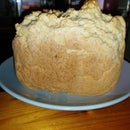Introduction: Lunch Bag to Camera Bag: the Convertion
Lunch's nice.
Camera's nice.
Let's put the two together.
Step 1: Luch to Camera.
Needing a Padded Camera bag, and being on a budget (Spent all my money on a new camera, and replacement phone), I needed a cheap, but effective bag.
Solution. Make one.
Being me, it had to be cheap, and I really did not want to make one from scratch. So,..... time to find a cheap bag I could convert.
To the Bat Internet Search Engine, Robin. WHOOSH, BAM, BOOM!
After searching all the local stores' stock, for cheap camera bags, I widened my search to include all padded bags with two compartments. This included lunch and nappy bags.
After looking at about 30 bag types, I narrowed it down to a Lunch Bag, with strap, that was padded, and water resistant.
I checked it's weight carrying capabilities in the description list, yes it could hold a camera and gear, and then I headed off to the store to see if I would buy it. I did!
I got it at my local Kmart, in Australia. This same type of bag is available at other stores, in different countries, I found from my search. A reverse image search will help you to find the same type of bag.
Step 2: How to Bake a Camera Bag. List of Ingredients.
List of ingredients.
- Lunch Bag - padded, with strap, about 300mm x 230mm x 270mm.
- 1 Foam Sheet - soft acoustic/anti-static/packing 300mm x 300mm x 25mm (or pieces of).
- 2 Velcro Elastic Straps - from you local haberdashery/$2 store/etc about 200mm long.
- 1 Velcro round tab set.
- 40mm wide Velcro strip - about 150mm long.
- Reusable Shopping Bag - plastic weaved material or equivalent.
- Sewing machine, thread, pins, hobby knife, scissors, measuring tape, pen.
Step 3: Lets Bake! Step One.
One of the first things, in fact the very first thing, is to remove the strap from the top section and move it down to the bottom section.
With the way the bag is made, when you open the bottom large pouch, it can swing open and down.
We want to be able to open the bottom, without all your camera gear falling out on the the ground!
Using the hobby knife, we are going to cut the thread holding the ring tab onto the top (lid) pouch.
*A tip when going to remove the tab, is to pull hard on the tab, as this will expose the thread more, making it easier to cut it, and not cut the bag.
After the ring tabs are removed, they are not connected together as one loop. Before putting them back on the bag, we sew the loop bottom shut.
You can see this in the picture, of the two ring tabs.
We are now going to sew them onto the top, of the bottom section, aligning them half way, from front to back.
We sew a square pattern with a cross (X) going through the square, to make the strongest connection, on the bottom of the ring tabs.
Step 4: Foamy Time. Episode "Fill Er' Up!"
The total area of foam used, was a 300mm x 300mm x 25mm thick piece of foam.
Next thing I did, was to measure the inside of the bag, for the foam bottom.
As I did not have a 300x300 piece of foam, but pieces, I glued them together, to get the bottom for the bag, and had two other pieces, 140mm x 80mm x25mm, that we will be using for end padded pieces.
The inside of the bag measured 280mm x 220mm.
One of these pads will get covered, as it serves double duty, as a camera rest, for when you are shooting.
* I used packing foam that is used to ship electronic components. Acoustic foam is the same sort of material. It is a Polyurethane Foam that comes in many forms. Just use the cheapest type, as the are nearly all the same in spec.
Step 5: Put It on My Tab.
Once I had placed the foam in the bottom of the bag, I next worked out, how I wanted my camera and lenses to be laid out inside.
I simply put the camera and two of my lenses in the bag, along with the charger, and moved them around till I liked the placement.
I kept in mind, that I did not want too many things floating freely around the bag, and that the lenses should be anchored to the bag, and easily got at.
I decided on dividing the inside into, two sections, with a removable panel, and elastic anchor points for the lenses in one section, and the camera in it's own section.
At this stage, I was working with two lenses in mind, and the camera.
I anchored the lenses with Elastic Velcro Straps, I got from the local $2 shop.
These are great from holding things together when you go camping, so I thought to use them in this camera bag.
I removed one part of the velcro from the end of the strap, and sewed it on the opposite side, part way down the strap, to hold the lense in tight. You can see this in the photos above.
*Make sure to sew the Hook Velcro piece onto the opposite side of the strap, from the Loop Velcro piece. So, when you put the lense in, it meets up.
When the lense position is worked out, after the velcro hook piece is sewn back on, the strap is held into place with a pin, and then sewn down, using the same square and cross (x) in the middle technique we used on the ring tabs.
Step 6: Divided They Don't Fall...
Now, on to the divider.
Before I even made the divider panel, I put the camera into the bag, and measured where I would place the divider, and hence where I would place the velcro tabs, used to hold the divider into place.
I used a velcro held divider, in case I changed my mind about the bag layout, and to allow for more flexible placement. I could add a longer divider, to accommodate a larger camera, at a later date, if so wished.
I could also put in more velcro tabs at a later date, in different positions, to give even more flexibility, if needed or wanted.
Once I decided on where to put the divider, I then placed and sewed on the velcro hook tabs. These were placed half way from the top of the bag, on opposite sides, as seen in the photo. One side of the bag is behind a front pocket, so the tab was sewn on by hand. The other side, machined on.
Next thing, was to measure the length of required material for the divider panel, taking into account the distance between the tabs, as well as, the length needed to stick it to the tabs. So, the bag inside width, plus the width of the velcro tabs, plus 10mm spare, at each end.
The material I used, was a leftover, reusable shopping bag. I used this, as it is a strong material, that is easy to sew, lasts some time, is soft, but can make a rigid form, when used in multiple layers.
It makes a soft, padded, and self standing divider when folded and stitched over.
I sewed the velcro loop pieces to the divider, as they are the softer bits to use.
As you can see in the photo's, I used the end of the bag, with the handle pieces still in place, and I folded the top over for extra strength and rigidity.
Extra points for counting the number of times I use the word "divider".
Step 7: Front and Centre
The bag has a front pocket, which when I went to use, kept letting things fall out.
So, I added a round velcro set to the middle of the flap..
This is a stick on set, but I have added stitching, as the glue always gives way, with this type of velcro sets, with use.
Step 8: Padded Pad.
The two foam pieces is used as extra protection for the front and side of the camera, one will pull double duty as soft camera rest, for shooting from rough surfaces.
Using more of the left over reusable shopping bag, I made a simple bag, measuring it slightly bigger than the foam block. Stitching it 7/8th of the way around, on the sewing machine, turning it inside out, so the seam is now inside the bag, I stuffed the foam block inside it.
I closed the open section by hand sticking the small opening.
Step 9: Nailed It! Er, I Meant, Finished It.
As you can see, there is room left in the middle.
Here is where I put another lense, and had room to carry my charger resting on top of that.
Both of the lenses are now in covers. The Velcro Straps are stretchy, so can easily fit the lenses with covers.
As you can see, the bag can now have its top pouch un-zipped, and the camera gear does not fall out.
The extra roomy top pouch is used to hold the batteries, filters, lense hood, lense clothes, etc.
Cost: $15 Lunch Bag
$4 Velcro tabs
$4 for two Velcro elastic strips.
$2 for reusable shopping bag
$0 for used foam. ($10 to buy if you were to buy it)
Total: $25!
Been using this bag for three months now, and it is still going strong.
Thanks for watching. :)













